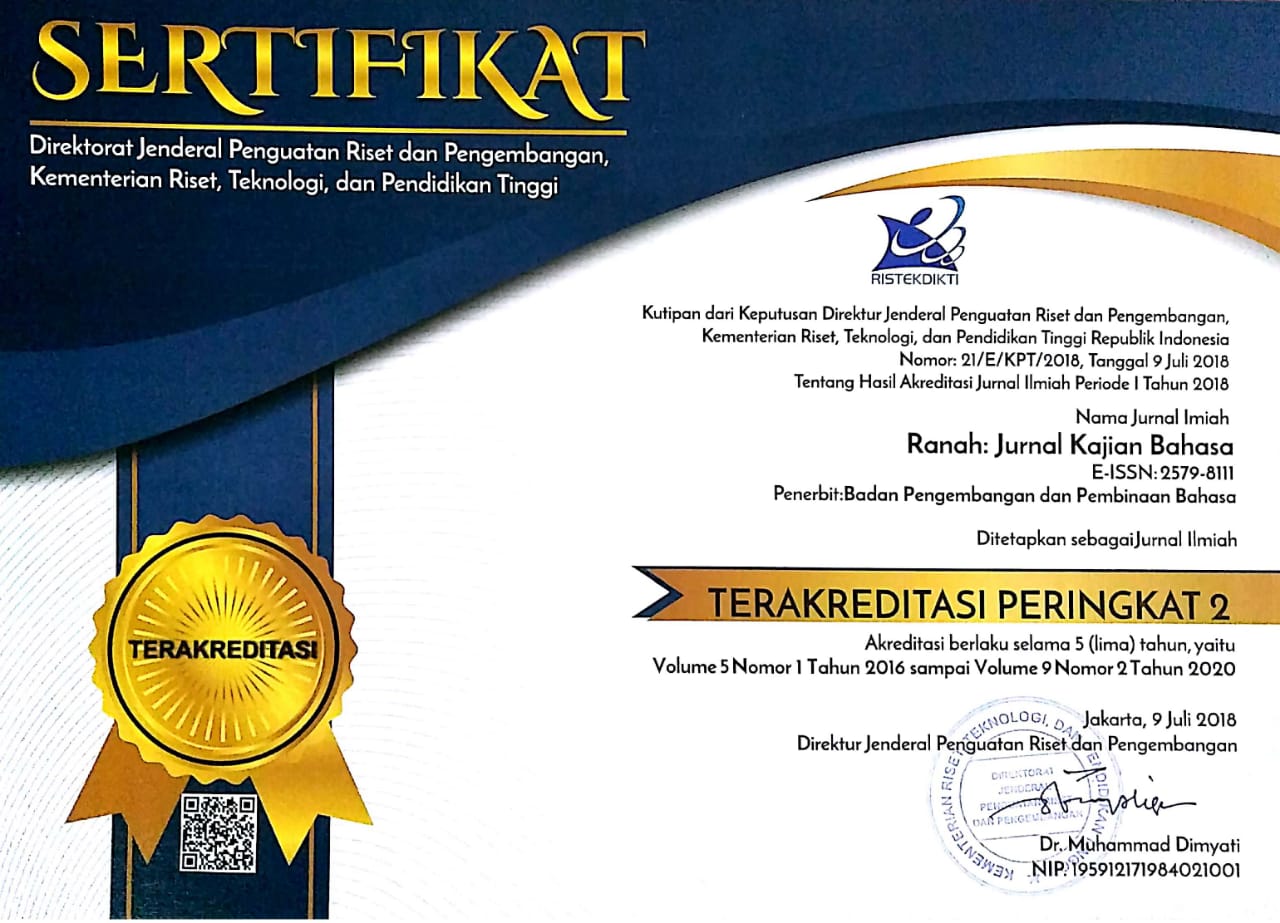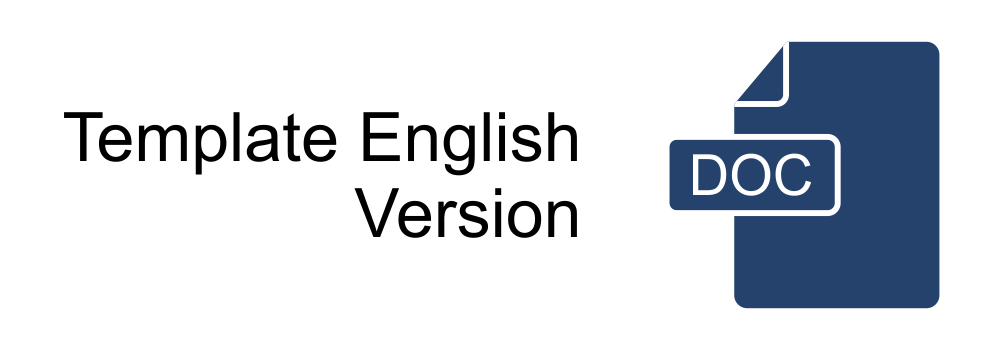Multilingualisme dan Kesetiaan Berbahasa Indonesia: Studi Lanskap Linguistik di Ruang Publik Pamekasan, Madura
Abstract
This study aims to describe the types of languages used and the loyalty to the Indonesian language in public spaces in Pamekasan. The research data consists of 704 linguistic objects in public spaces in Pamekasan such as street names, brand names, and business establishments, names of places of worship, names of trade complexes, names of offices, names of educational institutions, names of hospitals, building names, organization names, names of public facilities, road signs, and banners and product service advertisements. The results revealed the use of multiple languages in public spaces in Pamekasan, with eight language variations, including Indonesian, Indonesian and English, Indonesian and Arabic, English, Indonesian and Javanese, Indonesian and Madurese, Madurese, and other languages. Language loyalty to Indonesian in public spaces in Pamekasan was found to be relatively high, with pure Indonesian language use at 63%, Indonesian and other languages at 28%, and the use of regional and foreign languages at 9%.
Abstrak
Penelitian ini bertujuan untuk mendeskripsikan jenis bahasa dan bagaimana kesetiaan berbahasa Indonesia di ruang publik Pamekasan. Data penelitian ini sejumlah 704 objek linguistik di ruang publik Pamekasan seperti nama jalan, merk dagang & lembaga usaha, nama tempat ibadah, nama kompleks perdagangan, nama perkantoran, nama lembaga pendidikan, nama rumah sakit, nama gedung, nama organisasi, nama fasilitas umum, nama rambu umum & penunjuk jalan, dan nama spanduk dan iklan layanan produk. Hasilnya ditemukan multilingualisme penggunaan bahasa di ruang publik Pamekasan dengan 8 jenis variasi bahasa yakni bahasa Indonesia, bahasa Indonesia & Inggris, bahasa Indonesia & Arab, bahasa Inggris, bahasa Indonesia & Jawa, bahasa Indonesia & Madura, bahasa Madura, dan bahasa lainnya. Kesetiaan berbahasa Indonesia di ruang publik Pamekasan ditemukan masih cukup tinggi. Penggunaan bahasa Indonesia murni ditemukan sebanyak 63%, bahasa Indonesia dan bahasa lain 28%, dan bahasa daerah dan bahasa asing sebanyak 9%.
Keywords
Full Text:
PDFReferences
Afifah, N., & Hasibuan, N. S. (2018). Analisis Kesalahan Berbahasa pada Penulisan Media Luar Ruang di Wilayah Kota Medan. Linguistik : Jurnal Bahasa dan Sastra, 2(1), 14-37.
https://doi.org/10.24114/kultura.v1i1.11701
Astuti, T. (2019). Sikap dan Pemertahanan Bahasa Indonesia di Kalangan Akademisi (Tinjauan Deskriptif terhadap Fenomena Pemakaian Bahasa Indonesia). Seminar Nasional Pendidikan Bahasa dan Sastra , 154-163.
Beel, D., & Wallace, C. (2020). Gathering Together: Social Capital, Cultural Capital and The Value of Cultural Heritage in A Digital Age. Social & Cultural Geography, 21(5), 697-717.
https://doi.org/10.1080/14649365.2018.1500632
Ben-Rafael, E. (2008). A Sociological Approach to The Study of Linguistic Landscapes. In Linguistic Landscape (pp. 48-62). Routledge. https://doi.org/10.4324/9780203930960-9
Bouchard, M. E. (2019). Language Shift from Forro to Portuguese: Language Ideologies and the Symbolic Power of Portuguese on São Tomé Island. Lingua, 9(1), 271-228. https://doi.org/10.1016/j.lingua.2019.06.013
Bourdieu, P. (1991). Language and Symbolic Power. Polity Press.
Bulan, D. R. (2019). Bahasa Indonesia Sebagai Identitas Nasional Bangsa Indonesia. JISIPOL: Jurnal Ilmu Sosial dan Ilmu Politik, 3(2), 23-29.
Buzungu, H. F., & Rugkåsa, M. (2023). Lost in culture: Language discordance and culturalization in social work with migrants. Nordic Social Work Research. https://doi.org/10.1080/2156857X.2023.2216707
Chik, A., & Melo-Pfeifer, S. (2023). Do Societal and Individual Multilingualism Lead to Positive Perceptions of Multilingualism and Language Learning? A Comparative Study With Australian and German Pre-Service Teachers. Language Awareness. https://doi.org/10.1080/09658416.2023.2234288
Damayanti, E. (2019). Kesalahan Penggunaan Bahasa pada Iklan Komersial Media Luar Ruang di Kabupaten Kediri. Jubindo: Jurnal Ilmu Pendidikan Bahasa dan Sastra Indonesia, 4(2), 85-102.
https://doi.org/10.32938/jbi.v4i2.201
Firman, M., & Suhendra. (2020). Pemartabatan Bahasa Indonesia Ragam Tulis pada Ruang Publik: Sebagai Kontestasi Pasar dan Penegakkan Peraturan Penggunaan Bahasa. Seminar Internasional Riksa Bahasa.
Garvin, P. L., & Mathiot, M. (1968). The Urbaization of Guarani Language: Problem in Language and Culture. In Reading in Tes Sosiology of Language. The Hague.
https://doi.org/10.1515/9783110805376.365
Gautam, B. L. (2022). Aspects of language contact in Newar. International Journal of Multilingualism. https://doi.org/10.1080/14790718.2022.2069248
Grutman, R. (2019). Multilingualism. In Routledge Encyclopedia of Translation Studies (3rd ed., pp. 341-346). Routledge. https://doi.org/10.4324/9781315678627-73
He, Q. (2018). Quantitative Research in Systemic Functional Linguistics. English Language Teaching, 11(1), 110-119. https://doi.org/10.5539/elt.v11n1p110
Iye, R., Simpen, I. W., Sedeng, I. N., Netra, I. M., Said, I. M., & Abida, F. I. N. (2023). Language Contextualization in Public Space in Maluku Province: A landscape linguistics study. Cogent Arts & Humanities, 10(1). https://doi.org/10.1080/23311983.2023.2247648
Kartini, A., & Didin Sahidin. (2021). The Language Loyalty of Bilingual People in Boarding School Environment. Seloka: Jurnal Pendidikan Bahasa dan Sastra Indonesia, 10(1), 35-42. https://doi.org/10.15294/seloka.v10i1.40632
Kiramba, L. K. (2018). Language Ideologies and Epistemic Exclusion. Language and Education, 32(4), 291-312. https://doi.org/10.1080/09500782.2018.1438469
Kroskrity, P. V. (2018). On Recognizing Persistence in the Indigenous Language Ideologies of Multilingualism in Two Native American Communities. Language & Communication, 62, 133-144.
https://doi.org/10.1016/j.langcom.2018.04.012
Landry, R., & Bourhis, R. Y. (1997). Linguistic Landscape and Ethnolinguistic Vitality: an Empirical Study. Journal of Language and Social Psychology, 16(1), 23-49.
https://doi.org/10.1177/0261927X970161002
Li, S. (2016). English, Advertising and Positioning: The Impact of English on Chinese People's Daily Lives. Http://Dx.Doi.Org/10.1080/21698252.2016.1171455, 2(2-3), 77-93. https://doi.org/10.1080/21698252.2016.1171455
Mansyur, U. (2018). Sikap Bahasa dan Pembelajaran Bahasa Indonesia di Perguruan Tinggi. OSF.
https://doi.org/10.31227/osf.io/te3df
Motschenbacher, H. (2020). Walking on Wilton Drive: A linguistic landscape analysis of a homonormative space. Language & Communication, 72, 25-43.
https://doi.org/10.1016/j.langcom.2020.02.002
Nazriani, N., & Arsad, A. (2020). Kesalahan Penggunaan Bahasa Indonesia dalam Ruang Publik (Media Luar Ruang) di Kota Baubau. Sang Pencerah: Jurnal Ilmiah Universitas Muhammadiyah Buton, 6(1), 8-17. https://doi.org/10.35326/pencerah.v6i1.552
Nekula, M. (2021). Language Loyalty and Language Shift In Bohemia in the Long 19th Century Based on the Language Biography Of Friedrich (Bedřich) Smetana. Language and History, 64(2), 92-112. https://doi.org/10.1080/17597536.2021.1898126
Nguyen, T. T. T., & Hamid, M. O. (2016). Language Attitudes, Identity and L1 Maintenance: A Qualitative Study of Vietnamese Ethnic Minority Students. System, 61, 87-97. https://doi.org/10.1016/j.system.2016.08.003
Novita, R., Firdaus, W., & Budiono, S. (2021, December). Minangkabau Language Mapping Verification in West Sumatra Province. In International Congress of Indonesian Linguistics Society (KIMLI 2021) (pp. 284-291). Atlantis Press.
Olwig, K. R. (2022). David and Max Lowenthal - and Marsh: Public Intellectuals and Advocates in the Political Landscape. A Personal View. Landscape Research, 1-11. https://doi.org/10.1080/01426397.2020.1791811
Ou, W. A., & Gu, M. M. (2020). Negotiating Language Use and Norms in Intercultural Communication: Multilingual University Students' Scaling Practices in Translocal Space. Linguistics and Education, 57, 08-18. https://doi.org/10.1016/j.linged.2020.100818
Putikadyanto, A. P. A., Adriana, I., & Efendi, A. N. (2021). Presentation Culture in the Digital Age: Online Identity Representation on Social Media. Proceedings of the International Congress of Indonesian Linguistics Society (KIMLI 2021), 45-49.
https://doi.org/10.2991/assehr.k.211226.011
Rahman, M. M. (2020). Linguistic Diversity and Social Justice in (Bangla)Desh: A Socio-Historical and Language Ideological Perspective. Journal of Multilingual and Multicultural Development, 41(4), 289-304. https://doi.org/10.1080/01434632.2019.1617296
Rizkiansyah, R. A., & Rustono. (2017). Perilaku Berbahasa Pengembang Perumahan, Pengelola Hotel, dan Pengelola Toko. Seloka: Jurnal Pendidikan Bahasa dan Sastra Indonesia, 6(1), 25-33. https://doi.org/10.15294/SELOKA.V6I1.14750
Shohamy, E. (2019). Linguistic Landscape After a Decade: An Overview of Themes, Debates, and Future Directions. In P. Martin & M. Neele (Eds.), Expanding the Linguistic Landscape: Linguistic Diversity, Multimodality and the Use of Space as a Semiotic Resource (pp. 25-37). Multilingual Matters.
https://doi.org/10.21832/9781788922166-004
Strandberg, J. A. E. (2020). "Nordic Cool" and Writing System Mimicry In Global Linguistic Landscapes. Lingua, 235.
https://doi.org/10.1016/j.lingua.2019.102783
Sudaryanto, & Soeparno. (2019). Politics of Language in Indonesia (1975-2015): Study of History and Language Policy. Aksis: Jurnal Pendidikan Bahasa Dan Sastra Indonesia, 3(1), 129-139. https://doi.org/10.21009/AKSIS
Vivian, B. (2021). The Incitement: An Account of Language, Power, and Fascism. Rhetoric Society Quarterly, 51(5), 361-376. https://doi.org/10.1080/02773945.2021.1972134
Zhang, X., & Sheng, J. (2017). A Peircean semiotic interpretation of a social sign. Annals of Tourism Research, 64, 163-173.
https://doi.org/10.1016/j.annals.2017.04.002
DOI: https://doi.org/10.26499/rnh.v13i1.4584
Refbacks
- There are currently no refbacks.








